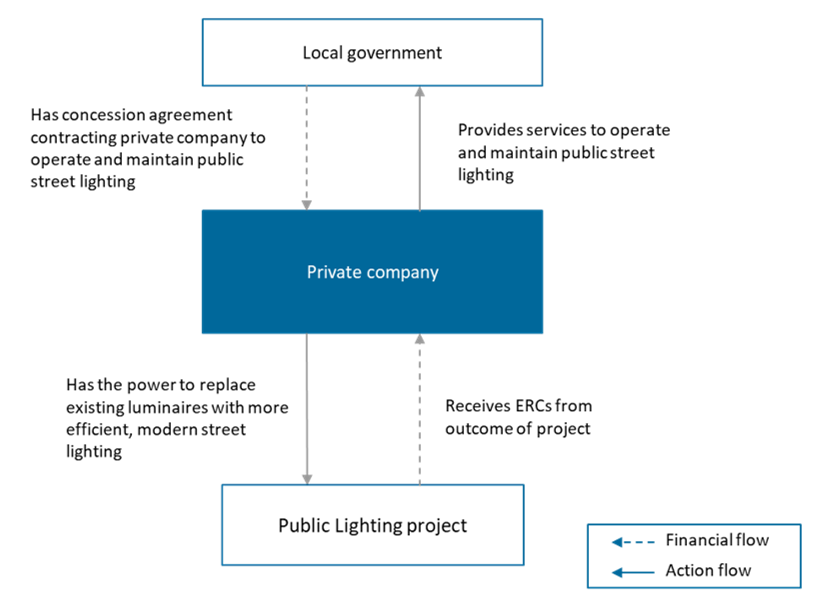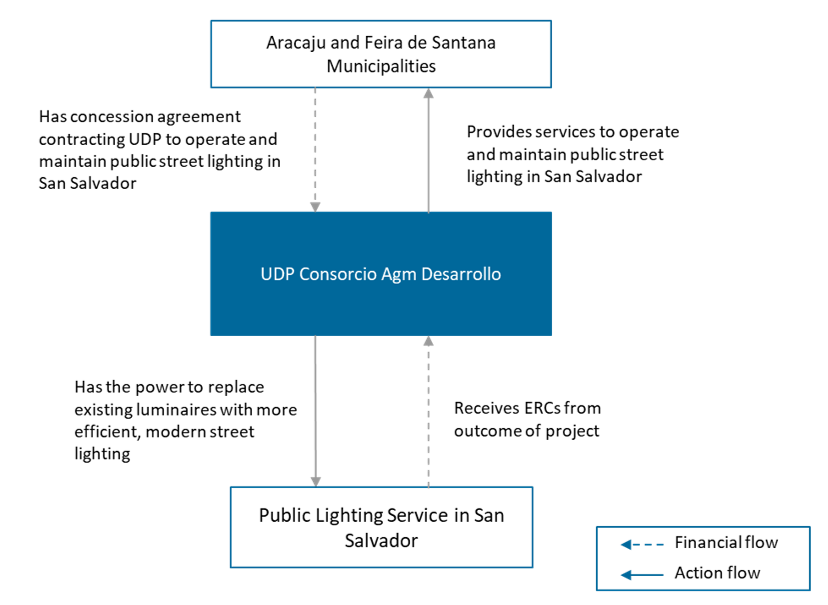LED Streetlight Deployment Model for ERP - for Efficient Outdoor and Street Lighting Technologies

Photo Credit: Image by Freepik
On this page: LED Streetlight Deployment for efficient outdoor and street lighting technologies leveraging an Existing-Refurbish-Finance-Bulk-Fees - Model 3 in the ERP Project Guidelines. Read more below, or visit Strategic Guidance for Country System Assessments, Guidance for Countries in Assessing ERC Projects, or Mobilizing ERC Finance.
Project Type: Energy efficiency
Sector: Energy - Power
Applicable Project Methodology: AMS.II.L Demand-side activities for efficient outdoor and street lighting technologies
This model describes project seeks to boost energy efficiency in public lighting infrastructure through the replacement of current luminaires with light-emitting diode (LED) lighting. It encompasses the installation, maintenance, expansion, replenishment, operation, and management of all public lighting infrastructure within the project area. Usage of more energy efficient luminaires reduces energy consumption hence minimizing greenhouse gas (GHG) emissions
The project will be leveraging an Existing-Refurbish-Finance-Bulk-Fees model. This will involve a municipal government or state-owned entity granting an experienced private sector entity a concession to replace the existing lighting in the target location. The private sector entity will be raising financing given that the assumed payment arrangements from the government or state- owned entity will be a percentage of the power consumption savings resulting from the project through a 10-year period. Table 1: Model Attributes Business New This model assumes that a competitive bidding among experienced project companies will take place Existing Construction Build The model involves the project company taking over and refurbishing current lighting infrastructure Refurbish Private Funding Finance The project company will be tasked with raising the funds for the installation of the LED lighting Service Bulk The project company will be collecting payments from the government or state-owned entity for the service of replacing the current lighting User Revenues Fees Revenues in this model will originate from the pre-agreed payments of the municipality to the private company for the service of replacing the current lighting Tariffs Proposed risk allocation of the Public Private Partnership Model Key features of PPP structure Key considerations/risks for proposed project Figure 1: Financing and Activity Flows for the Model Project description Impact The annual average estimate of GHG emission reductions and removals is 8,640,90 tonnes with the total for the crediting period being 86,408,98 tonnes. Given the small scale of the project in achieving savings below 20 gigawatts per hour, it was assessed to be additional by the verification body Colombian Institute for Technical Standards and Certification (ICONTEC). Aside from the emission reductions going towards El Salvador’s nationally-determined contributions (NDCs), the project improved the sense of security among the residents of the area in public spaces where the previous lighting were not functional. Figure 2: Structure of Case Study PPP The project proponent holds a concession contract with the Municipality of San Salvador, granting them temporary authority over the supply, installation, maintenance, expansion, modernization, replacement, operation, and administration of the municipality's lighting infrastructure. This grants UDP Consorcio Agm Desarrollo (UDP) the power to replace existing luminaries with LED lighting and to earn the ERCs associated with the reduced consumption of energy. Assuming a similar scale as the case study of replacing ~35,000 luminaries in total, the project’s Net Present Value (NPV) without ERC in- and outflows – only considering non-ERC inflows through other revenue streams or cost savings enabled by the project – is positive at $0.3M1. With ERC cashflows, the total project will have a greater positive NPV of $0.4M, which potentially increases the attractiveness of these type of projects for investors. There is also substantial NPV value for users that benefit from this projecting approximately $5.4M for net user benefit. This accounts for the estimated annual net electricity consumption savings. Table 2: Summary of sources of inflows and outflows and key assumptions ERC revenues or inflows Average price of Energy Efficiency project in Asia, Verified Carbon Standard (VCS) and Gold Standard (GS) Non-ERC revenues or inflows San Salvador Public Lighting case study benchmark, World Bank – Cost of Doing Business study Project investment and implementation cost San Salvador Public Lighting case study benchmark, Singapore LED replacement2 case study benchmark ERC generation Verra Fee Schedule Table 3: Net cashflows summary (in USD) ERC Component Revenues/Inflows 0 677,759 677,759 Costs/Outflows 0 -67,097 -67,097 Net value 0 610,662 610,662 Primary/Non-ERC Component Revenues/Inflows 0 4,554,371 4,554,371 Costs/Outflows -1,959,668 -195,967 -2,155,635 Net value -1,959,668 4,358,404 2,398,737 Net Present Values NPV $442,683 NPV (ERC Component) $183,244 NPV (Non-ERC Component) $259,439 NPV (Net user benefit) $5,378,349 Footnote 1: All prices are expressed in United States Dollars (USD) Footnote 2: VCS 1712Proposed Structure of this Public Private Partnership (PPP ) Model
Dimension
Attribute
Description


Case study: Public Lighting Service in San Salvador, El Salvador
The project sought to enhance energy efficiency in public lighting infrastructure by replacing existing luminaires with LED lighting in the urban area of San Salvador, El Salvador and was commenced in early 2017. It involves the installation, maintenance, expansion, replenishment, operation, and management of all public lighting infrastructure in the municipality. The project comprises two stages: Stage I involves replacing 27,436 old technology luminaires (16,088 Hg luminaries; 11,348 Na luminaries), while Stage II entails repowering and installing 7,510 new luminaires, totaling 34,946 luminaires.
San Salvador has an urban area of 72.25 km sq and a population of around 2.4 million (M) residents that benefit from this energy efficiency project.
Summary of the model financials
Value component
Assumptions
Sources
Components
Sum of initial outlays
Sum of in- or outflows from crediting period
Total cashflow
This section is intended to be a living document and will be reviewed at regular intervals. The Guidelines have not been prepared with any specific transaction in mind and are meant to serve only as general guidance. It is therefore critical that the Guidelines be reviewed and adapted for specific transactions. Unless expressly stated otherwise, the findings, interpretations, and conclusions expressed in the Materials in this Site are those of the various authors of the Materials and are not necessarily those of The World Bank Group, its member institutions, or their respective Boards of Executive Directors or member countries. For feedback on the content of this section of the website or suggestions for links or materials that could be included, please contact the PPPLRC at ppp@worldbank.org.
Updated: June 4, 2024
TABLE OF CONTENTS
UNLOCKING GLOBAL EMISSION REDUCTION CREDIT
Guidance for Countries in Assessing ERC Projects
1. Introduction to Emission Reduction Credits
• The World Bank's Emission Reduction Program
•Classification of Emissions Reduction Credit
• Policy Context of Emissions Reduction Credit
2. Objective of the Guidance for Countries in Assessing ERC Projects
• Objective of Project Preparation Guidelines
• Introduction to the Project Assessment Framework
• Process to Conducting Assessments
• S1: Green Economy Priorities
• S3: Article 6 Readiness and Eligibility
4. Conducting the Initial Profiling and Making a Preliminary Decision
• F2: Additional Value Enabled by Project
• C1, C2, and C3: Carbon Integrity and Environmental and Social Risk Management
5. Conducting the Project Assessment and Making the Final Decision
• F1: Project ERC value and F2: Additional Value Enabled by Project
• Q2: Marketing, Sales, and Pricing
• Q3: Project Governance and Structure
• C2: Environmental Risk Management
• C3: Social Risk Management and Benefits
6. Further Guidance for Application
• Country Context-driven Factors
• Considerations for Future Scope
Abbreviations: Guidance for Countries in Assessing ERC Projects
• B: Project Assessment Template
- Model 1: MRT Energy Efficiencies Model for ERP
- Model 2: Rural Electrification Model for ERP
- Model 4: Rooftop Solar Installation Model for ERP
- Model 5: LED Streetlight Deployment Model for ERP - for Specific Technologies
- Model 6: E-bus Deployment Model for ERP
- Model 7: EV Charging Systems Installation Model for ERP
- Model 8: Biodigesters Deployment Model for ERP
- Model 9: Waste-to-Power Model for ERP
- Model 10: Waste Treatment Facility Model for ERP
- Model 11: Climate Smart Farming Deployment Model for ERP